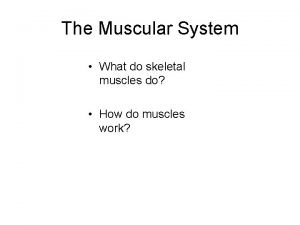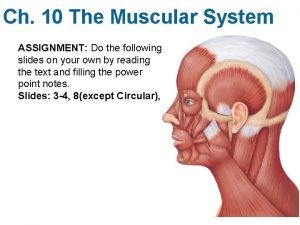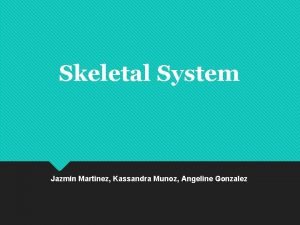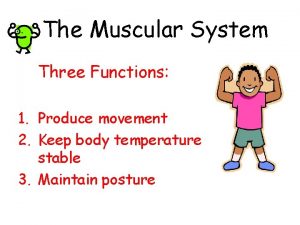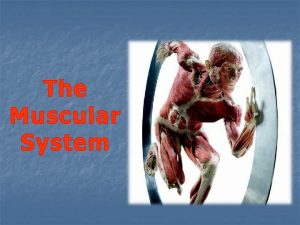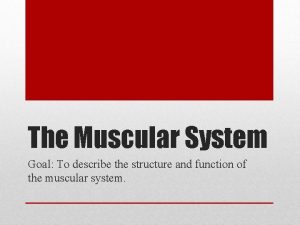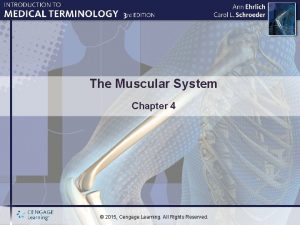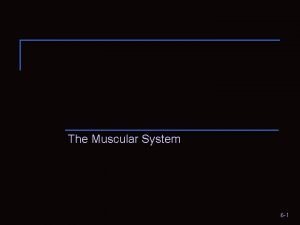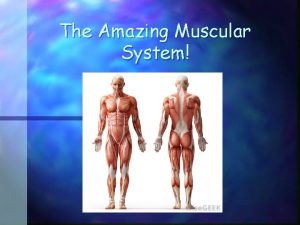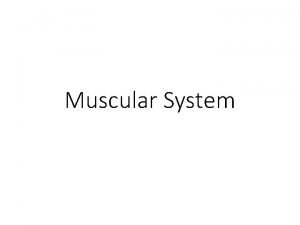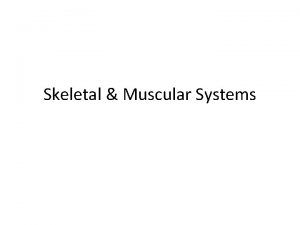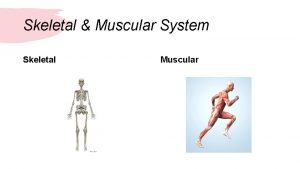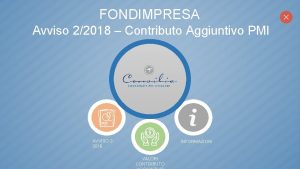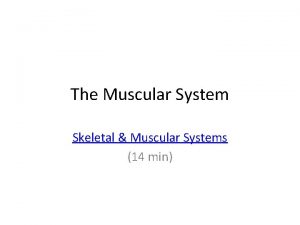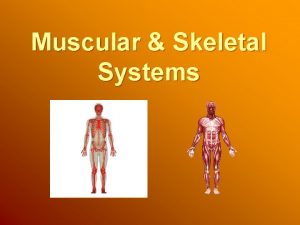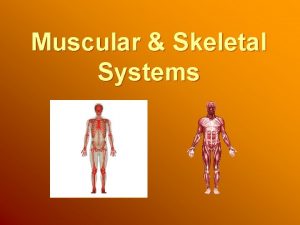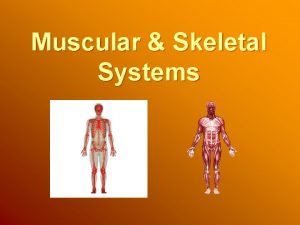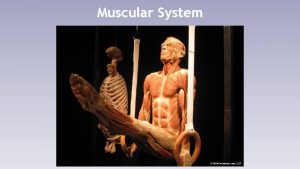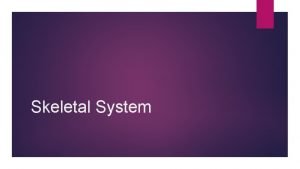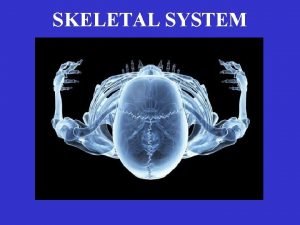Skeletal and muscular systems 22018 The Skeletal System














- Slides: 14

Skeletal and muscular systems 2/20/18

The Skeletal System • Composes the basic framework of the body • Protects vital organs from injury • Allows movement (along with muscles) • Stores minerals and produces red blood cells

The Skeletal System • Consists of 206 bones • Also includes ligaments and cartilage • Bones can be classified into 2 groups: – Axial skeleton (80 bones) – Appendicular skeleton (126 bones)

Axial skeleton • • Skull (25 bones) Spine (28 bones) Ribs (12 pairs) Sternum (3 fused bones)

Appendicular skeleton • Upper extremity (64 bones) – Shoulder/scapula – Upper arm and forearm – Hand • Lower extremity (62 bones) – Pelvic girdle – Leg – Foot

Bone classification • Long bones – Named for shape, not size. Has a shaft (diaphysis) and 2 ends (epiphysis) ex. Tibia, femur, humerus, ulna • Flat bones – Broad surface for maximal protection of vital organs Ex. Sternum, ribs • Short bones – Cube-like ex. Carpal bones of wrist

Bones cont’d • Irregular bones – Provide anchor support and protection of muscular tissue Ex. Talus (ankle bone) • Sesamoid bone – Embedded in a tendon and acts as a lever Ex. Sesamoid bones in foot, patella

Purpose of the muscular system • • Produce movement Produce heat Form posture Provide joint stability

3 types of muscle • Skeletal – Produces movement • Cardiac – Heart muscle • Smooth – Blood vessels, stomach, etc.

Characteristics of muscle • Contractibility: the ability to shorten or reduce distance between two parts • Excitability: the ability to respond to stimuli • Extensibility: the ability to lengthen and increase the distance between two parts • Elasticity: the ability to return to original forms after being stretched or compressed

Muscle attachment • Every skeletal muscle has 3 features: – Origin: the part of the muscle that is attached to the bone that moves the least during movement – Insertion: the part of the muscle that is attached to the part that moves the most – Belly: the central part of the muscle • Muscle attaches to: – Cartilage – Ligaments – Skin – Other muscles – Bones- when the muscle contracts, the bone it’s attached to moves

Muscle functions • Muscles in the body are arranged in pairs. – Agonist (primary mover): muscle that provides movement in single directions – Antagonist: the muscle whose action opposes that of the primary mover – Synergistic: muscles that help steady a movement or stabilize a joint

Muscle contractions • Isometric: very little movement is produced – there are co-contractions – Example: performing “quad sets” • Isotonic: movement occurs – Eccentric- the muscle lengthens as it contracts – Concentric- the muscle shortens as it contracts ü Think about flexion and extension at the elbow joint. What are the roles of the biceps and triceps muscles during these movements?

Muscle tone • Can be achieved through proper nutrition and resistance exercise (i. e. weight lifting). • Muscular hypertrophy: when individual muscle cells increase in size due to excessive exercise (high volume, low intensity) • Muscular atrophy: when muscle cell shrinks from disease or lack of movement.
 Chapter 36 skeletal muscular and integumentary systems
Chapter 36 skeletal muscular and integumentary systems Chapter 14 skeletal muscular and nervous systems
Chapter 14 skeletal muscular and nervous systems Major skeletal muscles
Major skeletal muscles Skeletal and muscular system
Skeletal and muscular system Plyometrics disadvantages
Plyometrics disadvantages Muscular system assignment
Muscular system assignment Angeline gonzalez
Angeline gonzalez Anatomy and physiology chapter 8 skeletal system
Anatomy and physiology chapter 8 skeletal system What do muscles move
What do muscles move Whats the function of the muscular system
Whats the function of the muscular system 4 functions of the muscular system
4 functions of the muscular system Chapter 4 the muscular system
Chapter 4 the muscular system Muscular system figure
Muscular system figure Simple muscular system diagram
Simple muscular system diagram Endomysium, perimysium, and epimysium
Endomysium, perimysium, and epimysium


